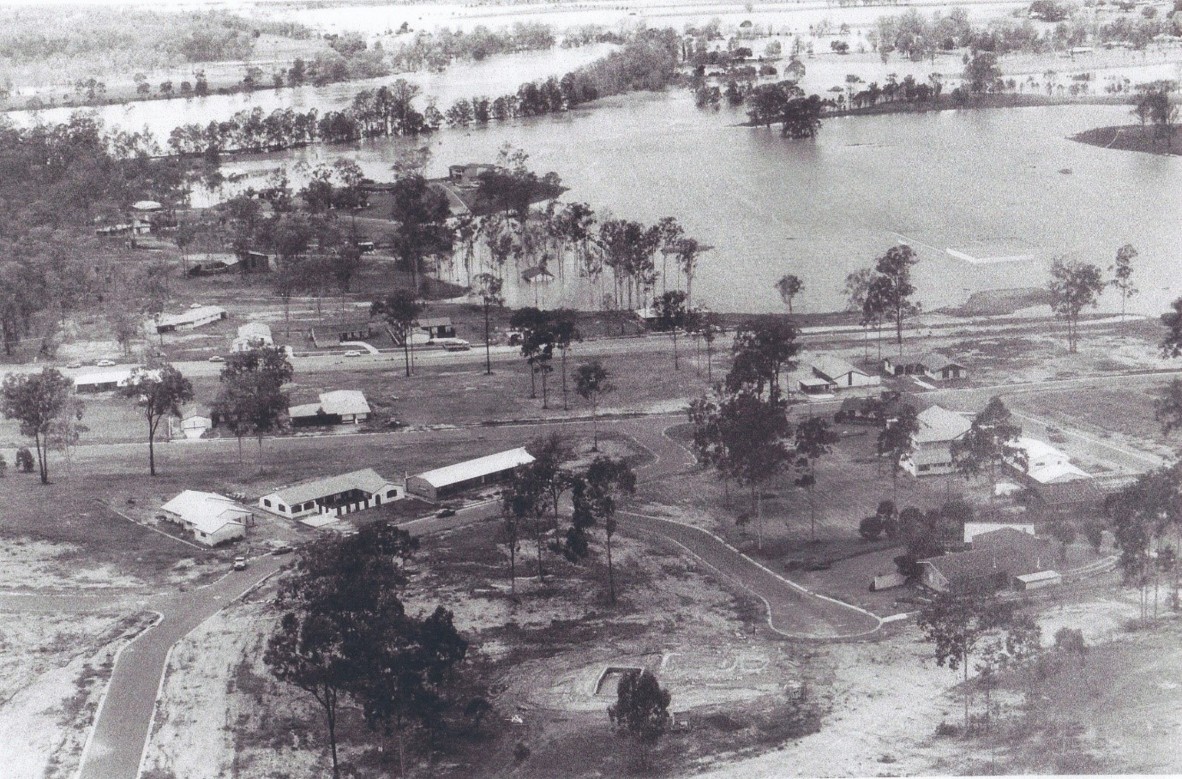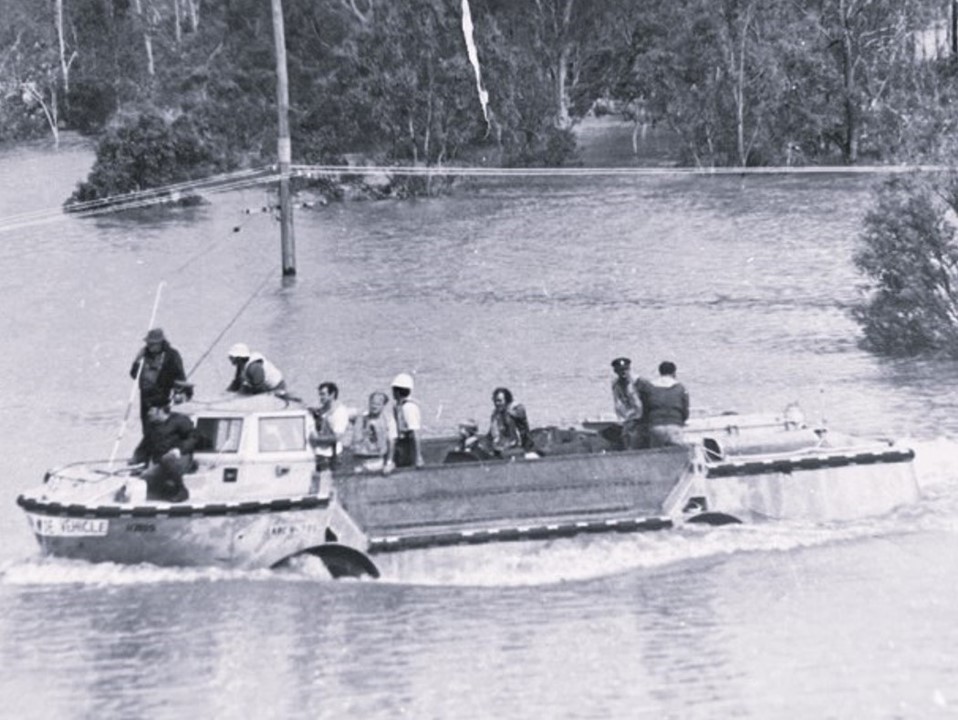1974 Bellbowrie Flood Deaths Remembered
By Guest Blogger: Neville Marsh from the Moggill Historical Society | 22 January 2024

A large part of Bellbowrie was inundated in January 1974. The roof of the newly opened shopping centre can be seen on the right. Photo: N A Marsh, courtesy of Moggill Historical Society.
Guest Blogger: Neville Marsh from the Moggill Historical Society
Fifty years ago, the worst floods of the century were about to wreak havoc in south-east Queensland. The newly created suburb of Bellbowrie was cut off from the rest of Brisbane by the end of January with residents needing food, medication and in some cases evacuation. The Australian Army had assembled personnel to assist in the supply and evacuation of civilians and to this end, three LARC-V (Lighter Amphibious Recovery Cargo) craft were dispatched to the marooned residents of Bellbowrie and Moggill. The lead vessel, LARC 05, was operated by Major Barry Rissel and crew members included Regular Army officers, Captains Ian Kerr and David Roubin and a Citizen Military Forces (CMF) soldier, Corporal Neville Hourigan. Bill Lickiss, Member of the Legislative Assembly for Mt Coot-tha was also on board with Dr Ross Jackson, a young trainee doctor from the Princess Alexandra Hospital. Bill had been invited to join the LARC crew with the specific role of contacting people, ascertaining their immediate requirements of food, fuel etc and determining put-down and pick-up points for supplies.
Captain Kerr and Coporal Hourigan were on the bow of the LARC and their task was to remove debris from the path of the craft and to negotiate fallen power and telephone cables. They had collected an elderly man, Hugh McIlroy, from his home in Weekes Road and were travelling back along Moggill Road through Bellbowrie with his son also Hugh and two children. Having passed the junction with Sugars Road, the LARC entered the water at a position near the present-day Bellbowrie Community Church. Earlier in the day, the crew had successfully negotiated several power cables in the water which were raised up by means of an aluminium boat hook and passed over the cabin of the LARC to passengers behind, who in turn passed the cables to the stern and dropped them back into the water. Everyone had reason to believe that the power had been turned off but sometime around 3.30 pm, as the LARC approached more high-tension cables, there was a “massive electrical discharge” as the electricity arced between the cable and the boat hook held by Ian Kerr.

LARC 05 immediately before the disaster showing Captain Kerr and Corporal Hourigan on the bow. Photo: Roger Todd, courtesy of Moggill Historical Society
Bill described the explosion like “welding, static noises and electric blast furnaces.” As a result of the explosion, there was “immediate pandemonium” as many of the occupants of the LARC were injured and some were thrown overboard including Ian Kerr and Neville Hourigan. Most of the passengers were in “various stages of panic and hysteria”. Barry Rissel “suddenly appeared on fire” and other occupants of the vessel suffered burns. A young couple, Kay and James Vagne, were sheltering in the cabin of the LARC with their three-week-old baby in a bassinette. Matthew was unharmed but the life jacket of Hugh Gilroy’s young grandson was “pitted with shrapnel.” Although Barry Rissel was “pretty weak and faint,” he remained standing and tried to keep control. He attempted to send out a mayday call on the radio and he recalls that his service cap disintegrated and as he left the LARC cabin on fire, Ross Jackson was able to extinguish his clothing. Two other passengers, Tony Johnson and Glen Suttie, were on the floor of the LARC, experiencing epileptic-type fits. Tony had fallen against Hugh Gilroy Junior who had his two children clinging to him for safety. Ross Jackson cleared the airways of the two men and rolled them onto their side, but he had no medical equipment to treat them further.
Bill Lickiss was thrown overboard unconscious and after regaining consciousness, found himself some distance from the LARC. He was dazed and unable to inflate his life vest. Having swum back to the damaged LARC, he climbed aboard. Only now did he see the severity of injuries sustained by Barry Rissell, Tony Johnson and Glenn Suttie as well as hearing the cries of shocked and injured people. Bill then saw a hand and head above the water and immediately dived in and swam towards to the person whom he recognised as Neville Hourigan. Bill Lickiss was able to grasp him by the life strap of his uninflated Mae West life jacket and kept him afloat by means of a cork lifebuoy. Having cleared Neville’s throat, Bill swam back to a second craft nearby, LARC 09, and he was heaved aboard. Sadly, Neville died shortly afterwards.
While Bill had been in the water, a voice was heard to call out: “We hit high tension wires. Get away from them.” David Roubin, who had been looking after Hugh Gilroy Senior and the children, moved forward from the stern of the LARC and took the controls of the vehicle. However, he had not driven one before and the LARC began drifting back towards the wires. David managed to get the vessel into reverse and moved the LARC slowly to safety. Fortunately, Corporal Ray Ruddy, an experience LARC operator, was a crew member on LARC 09 and swam across from the craft which had stayed on the other side of the power cables. Ray “immediately got into the cabin and got the motor running” and was able to drive LARC 05 out of the water up to Bellbowrie. Only then did the LARC crews realise that Ian Kerr was missing and a search was initiated. It was now past 4.00 pm and as a result of calls to the Duty Officer, 6 Task Force, three Kiowa helicopters arrived and landed at the top of the hill leading into Bellbowrie. They had great difficulty in finding the landing area as a storm had broken out and visibility was very poor. Nonetheless the helicopters were able to transport Neville Hourigan’s body and the injured men back to the Royal Brisbane Hospital. Ian Kerr’s body was not found for several hours, and it transpired that he had drowned in Pullen Pullen Creek.
This tragedy left two widows and four children without a father. In addition, many people were scarred for life both physically and mentally. A lengthy Coroner’s Inquest was held to determine the causes of death of the two soldiers and an Army Court of Inquiry also investigated the tragedy. As a result of several recommendations, Bill Lickiss and Ray Ruddy were both awarded the Queen’s Gallantry Medal.
The Brisbane City Council will be delivering a new flood memorial at Booker Place Park in Bellbowrie to commemorate the 50th anniversary of the deaths of Captain Ian Kerr and Corporal Neville Hourigan. The Lord Mayor will dedicate the memorial at 11.00 am on Sunday 28 January 2024, at Booker Place Park, Birkin Road, Bellbowrie. All are welcome to attend.
The Moggill Historical Society would like to hear from any of the passengers on the three LARC vehicles who may still be alive, or from eyewitnesses of the explosion or from anyone else who has information relating to the tragedy. You can contact them at president@moggillhistorical.au
Comments
Your email address will not be published.
We welcome relevant, respectful comments.